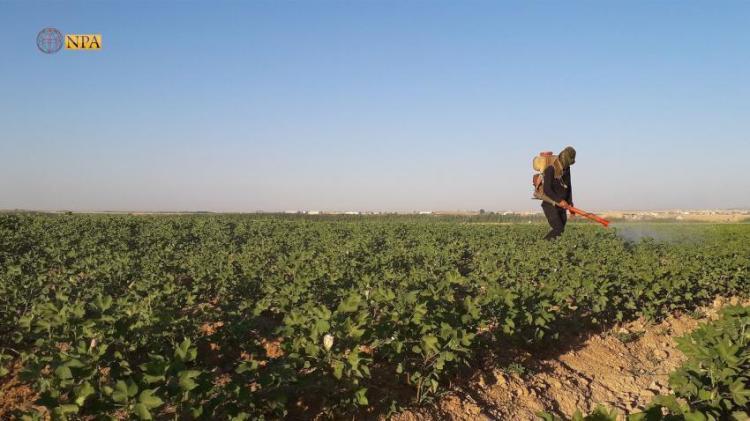Raqqa – North-Press Agency
Ahmad Al-Hassan
The spinal worm has caused a recession in cotton-growing over the past years in the countryside of Raqqa, northern Syria, leaving a decrease in production and an increase in treatment and prophylaxis costs during its planting.
Farmers in the region of Beir Al-Heshem and Al-Balikh Trough in the northern countryside of Raqqa, complain of the increased spread of the spinal worm in recent years.
“The worm hit our crops last year, and this year, it’s spreading more than in the previous years,” farmer Jumaa Al-Muhammad told North-Press.
Al-Muhammed said that the process of prophylaxis costs them a lot, saying, “One dunum of spraying with pesticides, needs more than SYP 3000,” adding “The field must be sprayed every 10 days in order to eliminate the worms”.
The high cost of growing cotton is not only confined to pesticides, but it also extends to other costs such as seeds, fertilizers, land preparation, cultivation, harvesting, and marketing.
In turn, farmer Redwan Al-Luhaibi says that “Planting one dunum of cotton, needs more than SYP 30,000 for the labor, seeds, and fertilizers,” noting that they’ve suffered heavy losses due to the eradication of the spinal worm in their crops.
In recent years, there has been a significant recession in the areas of growing cotton compared to the period of the pre-Syrian crisis. Agricultural engineer Abdul-Rahman Al-Mustafa said that “The agriculture department in the Syrian government was setting 35% of irrigated lands for growing cotton, but after the Syrian crisis, this average has receded to less than 10%”.
The Cotton is considered as one of the most important crops that is grown in the countryside of Raqqa due to the availability of its growing elements such as suitable environment, irrigating water and farmers’ experience. However, high costs of fertilizers, the spread of agricultural blights, the shortage of labor and the absence of official authority to receive the crops, all have led to the blackmail by crops dealers and made the cotton crops to be the last agricultural option for the farmers.

